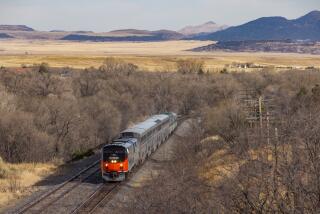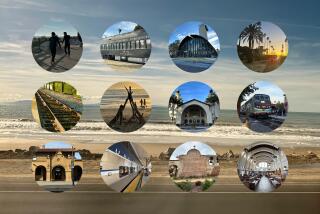These four trains can carry you from coast to coast, where the final prize awaits: the vast beauty of the West
On the morning of Aug. 12, my wife, Laurel, and I were in New York City’s Penn Station awaiting Amtrak’s Northeast Regional No. 141 to take us to Washington, D.C.
This would be the first leg of a 3,447-mile, four-train odyssey to Seattle — in the other Washington — and it would offer a window into Amtrak’s pleasures and problems.
Next would come the Capitol Limited to Chicago, then the Empire Builder to Portland, Ore., and the Cascades north to Seattle, concluding our three-night odyssey.
To ride and write about Amtrak in 2017 is to bounce among three reactions: gratitude that trains with sleepers and dining cars still cross America to show off its vast beauty; fear that their days could be numbered; and frustration that amenities and service standards have deteriorated.
I’m a lifelong train buff, and Laurel and I have ridden the rails in every state. I love the feeling of being on a train, the rumble and roar that seem to aid woolgathering, and I never tire of staring out the window, no matter the scenery.
Here are some of the things we saw, outside and inside:
Northeast Regional
We pulled out at 9:38 a.m., just three minutes late, and arrived in Washington on time at 1:05 p.m.
Of the three types of trains we would ride, this one was plain vanilla. The coaches were standard-issue Amfleet cars with undersized windows used throughout the East.
Though 40 years old, the cars are well made and, after refurbishing, look and ride just fine. There was ample leg room even in coach, so we skipped the upgrade to business class.
I had ridden this route, not Amtrak’s most scenic, countless times, and I always watch for certain landmarks: the “Trenton Makes, the World Takes” sign on a highway bridge over the Delaware River, the college boathouses that line the Schuylkill River in Philadelphia, and the spiffy little town of Havre de Grace, Md.
In Washington’s Union Station, we ate fried oysters at the Thunder Grill in the station’s soaring marble Main Hall. We had time for a short visit to the National Postal Museum, a favorite that’s free and right across the street from the station.
At the station’s ClubAcela (a lounge for sleeping-car and first-class passengers on Acela trains that run between Boston and Washington), we made our dinner reservation.
That meant that when we settled into our bedroom on the Chicago-bound Capitol Limited, we knew we would be dining at 7 p.m., our preferred time. (Dinner on overnight trains is by reservation. Breakfast and lunch are first come, first served, with waiting lists once the diner fills. Meals are included in the tab for sleeping-car passengers.)
Capitol Limited
The Capitol Limited is equipped with double-deck Superliner cars, the oldest of which date from October 1979. In the East only the Capitol and Virginia-Florida Auto Train use the cars (they don’t fit in the tunnels into New York City), but the overnight trains in the West generally do, so we would encounter them again in Chicago when we boarded the Empire Builder for Portland.
Aging equipment is an Amtrak woe, but our sleeper on the Capitol was spruce: freshly reupholstered, nicks and scrapes minimal.
Our bedroom, the premier sleeping accommodation, had a sofa and facing chair with a table between by day, upper and oversize lower berths by night, a sink and an annex with toilet and shower.
The train was still in suburban Washington when we secured seats in the Sightseer Lounge. It’s open to all passengers, so it’s an attractive option, which means seats can be hard to get.
These lounges are bright, spacious and inviting, with high, broad windows and skylights. I knew the pre-dinner scenery would be good: the Potomac River; the mostly dry Chesapeake & Ohio Canal, its towpath now a hiking trail; and the hillside town of Harpers Ferry, W. Va.
In the lounge I picked up a handout — “White House Budget Cuts All Long Distance Rail Service” — provided by the National Assn. of Railroad Passengers.
“States in black will have no trains,” its headline said. The map showed 27 states with 16 trains under threat, including the Capitol and the Empire Builder.
On a more mundane level, culinary sameness is an issue for passengers on multiday trips. A standard menu is offered on all long hauls, so what was proffered on the Capitol was what we would see on the Empire Builder.
The premier dinner entree was a Field and Sea Combo of shrimp and steak, priced at $36 (or you could order just shrimp or just steak). After three dinners we concluded the best entree was the chicken and bacon fettuccine carbonara. The offerings also included a vegan special, chicken breast, plus three “limited-availability” rotating entrees.
Breakfast, on the other hand, remained a highlight, with some items freshly prepared.
Amtrak practices communal seating, so others will join you. The tablemates we’ve encountered over the years — and certainly on this trip — have defined our dining-car experience.
Empire Builder
Now it was time to switch again, this time in Chicago to the Empire Builder bound for the West.
The demand for bedrooms in summer on Amtrak’s Western trains, including this one (which splits in Spokane, Wash., sending sections to Seattle and Portland), far exceeds supply.
Though we booked three months in advance, no bedroom was available to Seattle. So we decided to go to Portland, spending the night at the lovely old Benson Hotel, then taking the midday Cascade to Seattle.
The Portland section of the Empire Builder has just one sleeper, and we scored the last bedroom for a head-spinning $2,048.
After our first-time visit to elegant, spacious, year-old Metropolitan Lounge (like ClubAcela) in Chicago’s Union Station, we boarded the Empire Builder and at 2:15 p.m, headed north to Wisconsin’s dairyland.
From there we traversed Minnesota, running for miles along the Mississippi River; North Dakota; Montana; Idaho; Washington and, finally, Oregon.
Forty-six hours and five meals later, we arrived in Portland. Our sleeper showed its age, which even duct tape couldn’t ameliorate.
The train was sold out, which may explain why service in the diner was a cut below what we found on the Capitol.
Random thoughts and highlights: Bathed in late, low afternoon sun, Wisconsin looked picture-perfect and prosperous.
The next afternoon, as we sped across the baked, brown plains of eastern Montana, the scene was different — crumbling barns and abandoned houses. Although not uplifting, this landscape told a story too.
Mark and Liz, volunteer docents with “Trails and Rails,” cosponsored by the National Park Service and Amtrak, boarded in Havre, Mont., and would ride for six hours to Whitefish, Mont.
They talked about how a century ago the Great Northern Railway, whose ancestral rails we were riding, recruited settlers to come and homestead, leaving the empty legacy we’d witnessed.
The best scenery was next. Mountains emerged to the west, and then we snaked up to Marias Pass on the eastern border of Glacier National Park in Montana.
The next day we awoke as our now-truncated Portland-bound train began the morning-long, scenic run along the Columbia River, presided over by snowy Mt. Hood.
We lost our diner to the Seattle section but were happy with our tray breakfast in the Sightseer Lounge.
Cascades
For our last leg, we boarded the Cascades train for Seattle, a four-hour run, with glimpses of Puget Sound, in comfortable, Spanish-designed Talgo cars, used nowhere in America but on the Cascades.
At journey’s end we walked into century-old King Street Station, its interior gleaming with reclaimed luster, a heartening end to a decades-long restoration project and to our own not insubstantial journey.
If you go
Our Amtrak Guest Rewards points were too sparse to get us a bedroom in the Chicago-Portland Empire Builder, but we had enough for the Northeast Regional and Capitol Limited, so we spent 32,154 points for those legs of the trip. (Two years ago Amtrak revamped the Guest Rewards program and it’s now less advantageous for the traveler than it was.)
Currently, the number of points required for a trip is a direct equivalency of the dollar price of the ticket at the time of booking. Price, of course, varies by demand.
For reservations, go to Amtrak.com or call (800) 872-7245. There is no charge for booking by telephone.
More to Read
Sign up for The Wild
We’ll help you find the best places to hike, bike and run, as well as the perfect silent spots for meditation and yoga.
You may occasionally receive promotional content from the Los Angeles Times.






